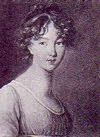
The late 19th century saw many publications filled with patterns for all sorts of fashion and household accessories in all kinds of media. The material culture of any era can speak volumes beyond its appearances and uses some of which are lost in time but should not be ridiculed or mocked for a lack of understanding in later times. A dainty item such as this lacy sponge tells of a society highly concerned with cleanliness, and which also had the time to create, let alone use, such an object, and treat it carefully, as the pattern states that it should always be “hung up where the air can pass freely through it.”
Many kinds of lace were popular in this era, again, for fashion and household accessories. This piece is knit in two lace circles which are then attached by double threading the blue cord though the outer eyelets. The pattern also suggests that “When necessary, unpick the blue stitching, which is purposely made conspicuous, wash and thoroughly dry the knitted sections, and again sew together.”
The pattern comes from Weldon’s Practical Knitter, Number 130, Thirty-Second Series (1896), published in Weldon’s Practical Needlework, Volume 11, Interweave Press, 2004.
The original pattern called for “unbleached knitting cotton, No. 8” and “four steel needles No. 9” whose modern equivalent is 3.75mm/US 5. I used DMC Baroque Crochet Cotton in Ecru. The interior is filled with “scraps of white rag” according to the pattern. The blue cotton cord, in Aunt Lydia’s Classic Crochet Size 10, was crocheted with a 2.50mm hook.

Weldon’s suggests a size, “if loosely worked, of nine inches across,” and mine came out at considerably smaller at just over 6” wide.
In spite of its name, the recommended use of this object is for cleaning windows.
{Note: All quotations are from the facsimile edition of Weldon’s Practical Needlework, Volume 11, published by Interweave Press, 2004.}


2 comments:
Cleaning windows? *blink*
I know - I had the same reaction!
Post a Comment